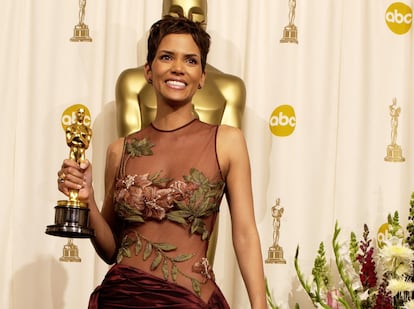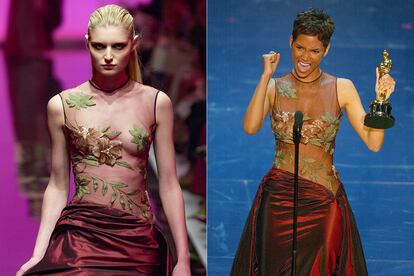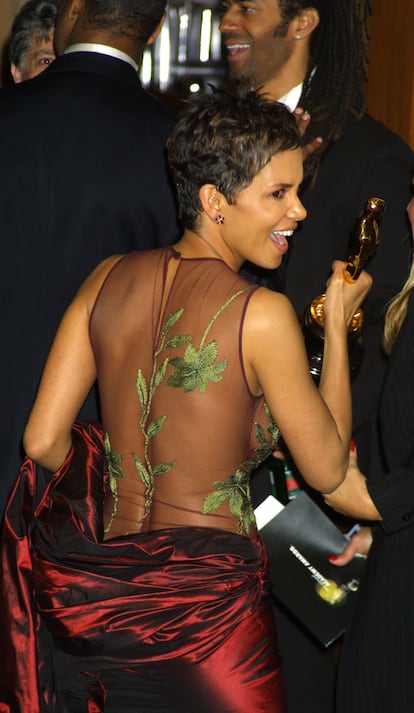The untold story of the dress in which Halle Berry made Oscars history
Designer Elie Saab’s career skyrocketed after the actress, who has an upcoming movie on Netflix this year, wore his creation when she became the first Black woman to win the Academy Award for best actress

Halle Berry, who stars in an upcoming Netflix sci-fi movie, The Mothership, made history without expecting to at all. When she arrived on March 24, 2002 at the Kodak Theater in Los Angeles, the actress didn’t hold out much hope of taking home an Oscar. “Back in those days, if you didn’t win the [Golden] Globe, you really didn’t get the Academy Award [...] So I’d pretty much resigned myself to believing, ‘It’s great to be here, but I’m not going to win.’” she recalled last year in an interview with The New York Times. But when she stepped onto the red carpet she certainly attracted a lot of attention: all eyes and cameras were on her and her dress, with its lining-free embroidered tulle body and bulky taffeta skirt. The Elie Saab dress instantly became part of Hollywood history when Berry, who was 35 years old at the time, won the Best Actress Oscar for her performance in Monster’s Ball, becoming the first and only Black actress to win the award in the 94-year history of the Academy. “This moment is for Dorothy Dandridge, Lena Horne, Diahann Carroll. It’s for the women that stand beside me, Jada Pinkett, Angela Bassett, Vivica Fox. And it’s for every nameless, faceless woman of color that now has a chance because this door tonight has been opened,” said an emotional Berry, whose fellow nominees were Nicole Kidman (Moulin Rouge), Judie Dench (Iris), Renée Zellweger (Bridget Jones’s Diary) and Sissy Spacek (In the Bedroom).
Year after year, the dress Berry wore in that historic moment has reappeared on lists of the most remembered Oscars dresses. It even has its own entry in Wikipedia; it is listed under the category of “Outstanding red carpet styles,” which also includes the green Versace dress that Jennifer Lopez wore to the Grammys in 2000 and the strapless dress with a pink feather skirt, also by Versace, that Penélope Cruz wore to the 2007 Oscars.
But how did the style come to be? The dress was not custom-designed for Berry, unlike many of the dresses that the most important guests wear to such events. Nor was it a style fresh off the catwalk at a time when it was common to see many of the designs from January’s Paris couture on the red carpet during the film awards season shortly thereafter. Berry’s dress was part of the Versace fall-winter 2002 collection that Lebanese designer Saab had presented over half a year earlier, on July 12, 2001, during the French capital’s fashion week.

Nowadays, many stars wear garments from previous seasons on the red carpet, but it was not common to do so in the 2000s. The dress was chosen by Phillip Bloch, the actress’s stylist (who has worked with other celebrities including Lindsay Lohan, River Phoenix, Salma Hayek, Will Smith, Jada Pinkett-Smith and Melania Trump). At first, he selected it for another client to wear at the Emmys, but in the end he decided that it had to be a cover look. And Berry was on a lot of them after taking home her award at the 74th Oscars. “I looked at it again and thought, ‘This is a winner’s dress, this is an Oscar dress,’ so it really was a matter of waiting for the right occasion,” the stylist explained in a 2002 interview with Canada’s The Globe and Mail.
In the article, Bloch said that although the actress immediately fell in love with the design, getting her to wear it to the gala wasn’t easy. The reason? The dress Saab had designed for the runway revealed too much to be worn to the televised Oscar ceremony. Today, see-through garments are commonplace at galas and red carpets, but the designer’s runway offering barely covered one of the breasts. Just two years later, Janet Jackson’s career was scandalized when she showed a nipple during her performance with Justin Timberlake at the 2004 Super Bowl. Bloch and Berry sensed that showing too much in that dress could cause problems, so they asked Saab for alterations. But because the couturier was in Paris, Hollywood seamstress Madeleine Aikenberg was the one who made the embroidery on the chest larger. She placed the sheets strategically to both reveal and conceal, and both she and Bloch eliminated the original dress’s back zipper.

“I feel that this dress, in terms of its style, symbolizes what the American woman is about, and in particular what the African-American woman is about ― comfortable and yet couture, simple but also ornate. It had flowers from nature and a couture skirt that was frivolous…. The dress wasn’t startling, but it was unforgettable,” the designer told The Globe and Mail. Indeed, Saab has acknowledged that it was the garment that gave his career a definitive boost. “Halle Berry made the name Elie Saab more popular… She managed to really put the name Elie Saab on the international market. [That time] was a better time for cinema in general. [Halle Berry] was the first woman of colour [to receive the Oscar award for Best Actress]… It was elegant and daring and chic. I think this moment was a very exceptional moment for cinema,” he explained in an interview with Vogue Australia in 2019. Saab began his career by opening a store in Beirut in 1982 at the age of 18; when the 2002 Oscars took place, he was 37 years old. Until that moment, the Lebanese creator’s most famous client had been Queen Rania of Jordan. After the 2002 Academy Awards, his designs began to creep into international events, and he was invited to join the French Chamber Syndicale de la Haute Couture.
The “unforgettable” dress that Saab designed in 2001 is now a museum piece. Coinciding with the most recent Oscars ceremony on March 13, the actress shared a snapshot of her big night with her Instagram followers. In the post, she commented that in 2021, the garment had become part of the collection of the Academy Museum in West Hollywood, Los Angeles. Berry emphasized the historical significance of the dress: “Not only will this historic @eliesaabworld gown remain in the expert care of the museum’s curators and conservators, but it will also be accessible to generations of people for whom the dress also holds meaning and forever be a reminder that all things are possible.”
Sign up for our weekly newsletter to get more English-language news coverage from EL PAÍS USA Edition
Tu suscripción se está usando en otro dispositivo
¿Quieres añadir otro usuario a tu suscripción?
Si continúas leyendo en este dispositivo, no se podrá leer en el otro.
FlechaTu suscripción se está usando en otro dispositivo y solo puedes acceder a EL PAÍS desde un dispositivo a la vez.
Si quieres compartir tu cuenta, cambia tu suscripción a la modalidad Premium, así podrás añadir otro usuario. Cada uno accederá con su propia cuenta de email, lo que os permitirá personalizar vuestra experiencia en EL PAÍS.
¿Tienes una suscripción de empresa? Accede aquí para contratar más cuentas.
En el caso de no saber quién está usando tu cuenta, te recomendamos cambiar tu contraseña aquí.
Si decides continuar compartiendo tu cuenta, este mensaje se mostrará en tu dispositivo y en el de la otra persona que está usando tu cuenta de forma indefinida, afectando a tu experiencia de lectura. Puedes consultar aquí los términos y condiciones de la suscripción digital.
More information
Archived In
Últimas noticias
Mexico seeks to shore up its defenses following US incursion in Venezuela
Hope gives way to uncertainty among Venezuelan exiles in the US after Maduro’s capture
Cubans look to Venezuela fearfully after Trump’s incursion: ‘We could be next’
The operation in Venezuela to capture Maduro threatens to widen the cracks in the MAGA movement
Most viewed
- Alain Aspect, Nobel laureate in physics: ‘Einstein was so smart that he would have had to recognize quantum entanglement’
- Gilles Lipovetsky: ‘If you want to live better and fall in love, take Prozac, don’t look to philosophy’
- Alvin Hellerstein, a 92-year-old judge appointed by Bill Clinton, to preside over Maduro’s trial in New York
- Cuba confirms death of 32 of its citizens in the US attack against Venezuela
- Why oil has been at the center of Venezuela-US conflicts for decades










































